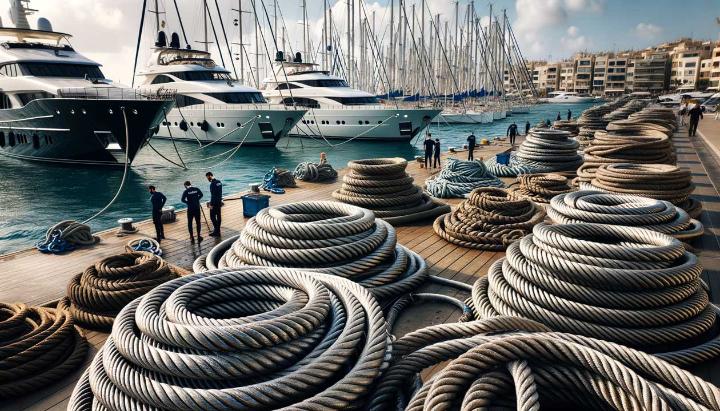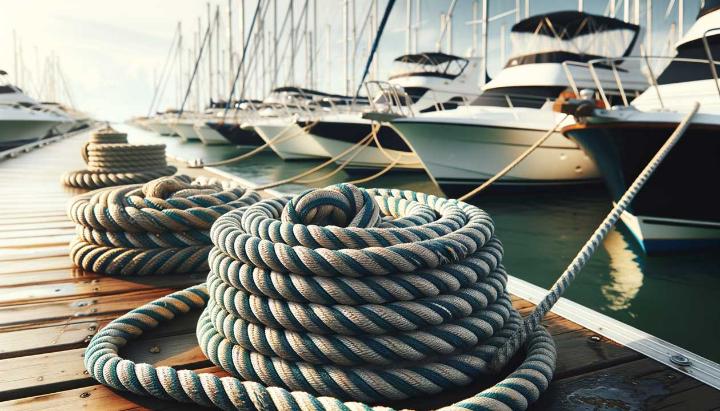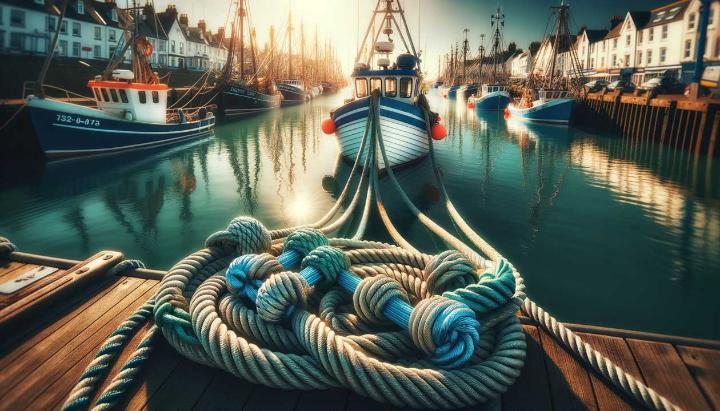Imagine a towering vessel, its hull cutting through the turbulent waters as it approaches the dock. In this moment, the fate of your ship rests upon a seemingly simple, yet crucial line – the mooring rope. This unsung hero bears the immense responsibility of securing your vessel, steadfastly anchoring it against the relentless forces of nature.
But choosing the right ship mooring rope is far from a trivial task. With countless options available, each boasting its own unique set of properties and performance characteristics, navigating the labyrinth of rope for ship materials can be daunting.
In this comprehensive guide, we'll demystify the art of selecting the perfect 3 inch ship rope or ship mooring rope for your vessel. From dissecting the strengths and limitations of various materials to understanding the nuances of rope performance, we'll equip you with the knowledge to make an informed decision that safeguards your ship and crew against the perils of the high seas.
Understanding the Different Types of Ship Mooring Ropes
Mooring ropes play a crucial role in securing vessels to docks, piers, or other fixed structures, ensuring their safety and stability during loading, unloading, and berthing operations. When it comes to choosing the right mooring line for your ship, understanding the different types and their characteristics is essential. The primary types of mooring ropes used in the maritime industry are chain, wire, and synthetic fiber.
Chain Mooring Lines
Chain mooring lines are renowned for their strength and durability, making them an excellent choice for heavy-duty applications. These lines are constructed from interlocking metal links, providing exceptional resistance to abrasion and cutting. While chain mooring lines offer robust performance, they can be quite heavy and rigid, potentially causing challenges in handling and storage.
- Suitable for large vessels operating in harsh environments or deep waters, where their weight and strength are advantageous.
- Preferred in high-traffic areas or locations prone to strong currents or tidal variations, as their rigidity helps maintain the vessel's position.
- Often used in conjunction with synthetic fiber ropes for added versatility and shock absorption.
Wire Mooring Lines
Wire mooring lines are constructed from strands of high-strength steel wires twisted or braided together. These lines boast an impressive strength-to-weight ratio, making them a popular choice for various mooring applications. Wire ropes are known for their durability and resistance to abrasion, ensuring a long service life.

- Suitable for medium to large vessels where their high strength and compact design are advantageous.
- Preferred in applications requiring minimal elasticity, such as in strong currents or tidal variations.
- Often used in conjunction with synthetic fiber ropes to leverage their complementary properties.
Synthetic Fiber Mooring Ropes
Synthetic fiber mooring ropes are lightweight, flexible, and highly resistant to deterioration from exposure to water, UV radiation, and chemicals. These ropes are typically made from materials such as nylon, polyester, polypropylene, or high-performance fibers like UHMWPE (Ultra-High Molecular Weight Polyethylene).
- Nylon ropes offer excellent strength, elasticity, and resistance to abrasion, making them suitable for various mooring applications.
- Polyester ropes are known for their strength, durability, and resistance to UV radiation, making them ideal for outdoor use.
- Polypropylene ropes are lightweight, buoyant, and resistant to chemicals, suitable for applications in chemical environments.
- UHMWPE ropes are renowned for their exceptional strength-to-weight ratio, abrasion resistance, and low stretch, making them a popular choice for high-performance applications.
When selecting the appropriate synthetic fiber mooring rope, consider factors such as the vessel's size, mooring conditions, and the specific performance requirements. These ropes offer versatility, ease of handling, and excellent shock absorption, making them a preferred choice for many maritime applications.
Remember, choosing the right mooring line type is crucial for ensuring the safety and secure mooring of your vessel. Consider factors like vessel size, water depth, weather conditions, and mooring location to make an informed decision that meets your specific requirements.
Factors Affecting Mooring Rope Performance
When it comes to securing your vessel safely and reliably, understanding the factors that can impact the performance of your mooring ropes is crucial. Mooring ropes are subject to a variety of environmental and operational stresses that can take a toll on their strength and durability over time. The main factors that can affect the performance of your mooring ropes are fatigue, abrasion, creep, and temperature.
Fatigue, Abrasion, Creep, and Temperature
- Fatigue is a gradual process that occurs when a mooring rope is repeatedly subjected to cyclic loading, causing a decrease in its overall strength. Over time, this can lead to internal damage and, in severe cases, catastrophic failure. Imagine a rope being stretched and released repeatedly, like the constant tugging of a ship against its moorings during a storm.
- Abrasion is another significant factor that can compromise the integrity of your mooring ropes. As the rope rubs against rough surfaces, such as the dock or other mooring lines, the outer fibers can become damaged or even severed, weakening the rope's overall strength. Think of a rope being slowly sanded down with every contact, gradually wearing away its protective outer layers.
- Creep is a phenomenon that occurs when a rope is subjected to constant tension, causing it to slowly elongate over time. This can be problematic, as it can lead to unexpected slack in the line, potentially compromising the vessel's secure mooring. It's like a rubber band gradually stretching and losing its elasticity when held under constant tension.
- Temperature can also have a significant impact on the performance of mooring ropes. Extreme heat can cause the rope fibers to become brittle and more susceptible to damage, while extreme cold can make the rope stiff and less pliable, potentially reducing its ability to absorb shock loads. Imagine a rope becoming as rigid as a metal cable in freezing temperatures or as fragile as dry spaghetti when exposed to intense heat.

Real-world examples of the impact of these factors abound in the maritime industry. Imagine a scenario where a vessel's mooring lines have been subjected to years of constant tension and abrasion against the dock. Over time, the ropes may show signs of creep, elongation, and visible external damage, potentially compromising their ability to securely hold the vessel in place during adverse weather conditions or strong currents.
Mooring Rope Inspection and Maintenance
To ensure the safe and reliable performance of your mooring ropes, regular inspections and maintenance are essential. During inspections, it's crucial to look for signs of damage, such as abrasion, stiffness, discoloration, or visible external damage like melted fibers or a decrease in the rope's diameter.
Proper handling, storage, and lubrication can also play a significant role in prolonging the lifespan of your mooring ropes. Always follow the manufacturer's recommendations and industry best practices for inspection, maintenance, and replacement schedules.
Remember, the safety and security of your vessel depend on the integrity of your mooring lines. By understanding the factors that can affect their performance and taking proactive measures to inspect, maintain, and replace them when necessary, you can ensure a reliable and secure mooring system that can withstand the challenges of the marine environment.
Selecting the Best Ship Mooring Rope for Your Vessel
When it comes to ensuring the safety and stability of your vessel, selecting the right mooring rope is of paramount importance. Mooring ropes are the lifelines that securely anchor your ship to the dock or pier, protecting it from the whims of wind, waves, and currents. With so many options available, choosing the perfect rope for your specific needs can be a daunting task. But fear not, we've got you covered!

Factors to Consider When Choosing Mooring Ropes
Before diving into the world of mooring ropes, it's essential to understand the key factors that will guide your decision-making process. Think of it as a checklist to ensure you're ticking all the right boxes:
- Rope strength and vessel size - The strength of your mooring rope should be directly proportional to the size and weight of your vessel. A larger ship will require ropes with a higher breaking strength and working load limit to withstand the immense forces at play.
- Elasticity and energy absorption - Imagine your mooring rope as a shock absorber for your vessel. A certain degree of elasticity is crucial, allowing the rope to stretch and recover, effectively dissipating the energy from waves, currents, and other external forces. This helps protect your ship from potential damage.
- UV resistance and abrasion resistance - Mooring ropes are constantly exposed to the elements, including harsh sunlight and abrasive surfaces like docks and fenders. Look for ropes with superior UV resistance and abrasion resistance to ensure a longer lifespan and optimal performance.
- Rope diameter and handling - The diameter of your mooring rope plays a significant role in its load capacity and ease of handling. A 3-inch ship rope, for instance, offers a perfect balance between strength and manageability for many vessels. Remember, the rope should be at least half the length of your ship and easily accessible from the cockpit.
Types of Mooring Ropes and Their Advantages
Now that you're armed with the essential factors to consider, let's delve into the different types of mooring ropes and their unique advantages:
- Nylon mooring ropes - Nylon is a popular choice for its excellent strength, elasticity, and resistance to abrasion. These ropes can stretch and recover from sudden loads, making them ideal for absorbing shock and protecting your vessel. However, they may be more susceptible to UV degradation over time. For more insights on nylon ropes' performance, check out Discover Our New Abrasion-Resistant Nylon Braid Ropes for Sale.
- Polyester mooring ropes - Polyester ropes boast superior strength and durability, coupled with exceptional resistance to UV radiation. They're a great choice for outdoor applications and may offer a longer lifespan than nylon ropes in certain environments. However, they tend to have slightly less elasticity than their nylon counterparts.
Other rope materials like polypropylene and high-modulus polyethylene (HMPE) can also be viable options, depending on your specific needs and operating conditions. For instance, polypropylene ropes are lightweight, buoyant, and resistant to chemicals, making them suitable for use in chemical environments.
As you can see, each type of mooring rope has its own unique set of advantages and potential drawbacks. It's crucial to weigh these factors against your vessel's specific requirements, the environmental conditions you'll be operating in, and your budget constraints.
Remember, investing in high-quality mooring ropes from reputable manufacturers can mean the difference between a secure and safe mooring experience, and a potential disaster on the high seas. Don't compromise on quality when it comes to protecting your vessel and ensuring the safety of your crew. For a deeper understanding of UHMW ropes, explore our article on UHMW Rope: Advantages and Applications.
Choosing the right ship mooring rope is vital for ensuring vessel safety and stability. Key factors include material type, strength, elasticity, resistance to environmental conditions, and handling ease. Different materials serve various needs: synthetic fibers like nylon, polyester, and polypropylene offer flexibility and UV resistance; wire ropes provide high strength; chain mooring lines excel in heavy-duty applications. A 3 inch ship rope balances manageability and load capacity, making it ideal for many vessels. Assessing your specific mooring requirements and environmental challenges will guide you to the best rope for your ship.
Contact Us for Tailored Mooring Solutions
Please complete the inquiry form above for expert assistance in selecting the perfect rope for your ship. Our specialists at iRopes are ready to provide customised solutions that meet your specific needs and ensure optimal performance and safety.